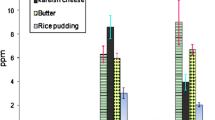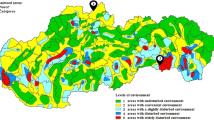Abstract
The monitoring of various elements in the cow milk is important in the agricultural sector. The goal of this study was to determine the concentrations of calcium (Ca), cadmium (Cd), copper (Cu), iron (Fe), mercury (Hg), potassium (K), magnesium (Mg), sodium (Na), nickel (Ni), lead (Pb), and zinc (Zn) in the milk samples coming from different origins (local region in Nitra, nationwide sample represents the common Slovak brands of milk and common brands of milk from Czech Republic widely available in Slovakia). The samples were analyzed using atomic absorption spectrometry. A high level of variability in the Cu, Fe, Na, Ni, and Zn contents was observed. Magnesium was comparatively high in the milk sample from Slovakia (273.23 ± 16.32 μg/mL) against sample from Nitra (230.91 ± 9.48 μg/mL) and Czech Republic (202.70 ± 10.83 μg/mL). Potassium was significantly higher in milk from Nitra region (3301.98 ± 95.66) against SK sample (2925.16 ± 75.74 μg/mL). There were no significant differences in other elements among the three regions. The provisional tolerable weekly intake (PTWI) contribution suggested low dietary exposure to observed toxic metals (Cd, Hg, and Pb) in milk samples. Margin of exposure (MOE) evaluation denoted that even higher consumption of milk poses no high cardiovascular and nephrotoxicity threat. However, Cd and Pb are known for their cumulative effect and the monitoring of these elements in milk is strongly required.
Similar content being viewed by others
References
Kurajdova K, Taborecka-Petrovicova J (2015) Literature review on factors influencing milk purchase behaviour. Int Rev Manag Market 5(1):9–25
FAO Statistics Division, Milk consumption—excluding butter (total) (kg/capita/yr) [online]. FAOStat (2011) Available on the Internet: http://chartsbin.com/view/1491
Kurajdova K, Taborecka-Petrovicova J, Kascakova A (2015) Factors influencing milk consumption and purchase behaviour—evidence from Slovakia. Procedia Econ Financ 34:573–580
Bilandzic N, Sedak M, Calopek B, Luburic DB, Kolanovic BS, Varenina I, Dokic M, Kmetic I, Murati T (2016) Lead concentrations in raw cow and goat milk collected in rural areas of Croatia from 2010 to 2014. Bull Environ Contam Toxicol 96:645–649
Schuhmacher M, Borques AM, Domingo LJ, Garbella J (1991) Dietary intake of lead and cadmium from foods in Tarragona Province, Spain. Bull Environ Contam Toxicol 46(2):320–328
Uluozlu OD, Tuzen M, Mendil D, Soylak M (2009) Assessment of trace element contents of chicken products from Turkey. J Hazard Mater 163:982–987
Stawarz R, Formicki G, Massanyi P (2007) Daily fluctuations and distribution of xenobiotics, nutritional and biogenic elements in human milk in Southern Poland. J Environ Sci Health A 42(8):1169–1175
Dobrzanski Z, Kolacz R, Gorecka H, Chojnacka K, Bartkowiak A (2005) The content of microelements and trace elements in raw milk from cows in the Silesian region. Pol J Environ Stud 14(5):685–689
Herwing N, Stephan K, Panne U, Pritzkow W, Vogl J (2011) Multielement screening in milk and feed by SF-ICP-MS. Food Chem 124(3):1223–1230
Zheng N, Wang Q, Zhang X, Zheng D, Zhang Z, Zhang S (2007) Population health risk due to dietary intake of heavy metals in the industrial area of Huludao city, China. Sci Total Environ 387(1–3):96–104
Pavlovic I, Sikiric M, Havranek L, Plavljanic L, Brajenovic N (2004) Lead and cadmium levels in raw cow milk from an industrialised Croatian region determined by electrothermal atomic absorption spectrometry. Czech J Anim Sci 49(4):164–168
Codex Alimentarius Commission (2003) Report of the 35th session of the Codex Committee on Food additives and contaminants, Arusha, Tanzania
Khan N, Jeong IS, Hwang IM, Kim JS, Choi SH, Nho EY, Choi JY, Park KS, Kim KS (2014) Analysis of minor and trace elements in milk and yogurts by inductively coupled plasma-mass spectrometry (ICP-MS). Food Chem 147:220–224
Kapsdorferova Z, Nagyova Ľ (2005) Consumer behaviour at the Slovak dairy market. Agric Econ 51(8):362–368
Binkowski LJ, Stawarz R, Zakrzewski M (2013) Concentrations of cadmium, copper and zinc in tissues of mallard and coot from southern Poland. J Environ Sci Health B 48(5):410–415
Semla M, Schwarz P, Mezey J, Binkowski LJ, Blaszczyk M, Formicki G, Gren A, Stawarz R, Massanyi P (2017) Biogenic and risk elements in wines from the Slovak market with the estimation of consumer exposure. Biol Trace Elem Res 184:33–41. https://doi.org/10.1007/s12011-017-1157-1
Capcarova M, Harangozo L, Toth T, Schwarczova L, Bobkova A, Stawarz R, Guidi A., Massanyi P (2017) Detection of selected trace elements in yogurt components. J Environ Sci Health B, 52(12):858–863
Binkowski LJ, Rogozinski P, Blaszcyk M, Semla M, Melia PM, Stawarz R (2016) Relationship between air pollution and metal levels in cancerous and non-cancerous lung tissues. J Environ Sci Health A, 51(14):1303–1308
EFSA Scientific opinion on lead in food (2010) EFSA panel on contaminants in the food chain. European Food Safety Authority, Parma. EFSA J 8(4):1570, https://doi.org/10.2903/j.efsa.2010.1570
Constable P, Grünberg W, Staufenbiel R, Stämpfli HR (2013) Clinicopathologic variables associated with hypokalemia in lactating dairy cows with abomasal displacement or volvulus. J Am Vet Med Assoc 242:826–835
Flynn A (1992) Minerals and trace elements in milk. Adv Food Nutr Res 36:209–252
Trefz FM, Lorch A, Zitzl J, Kutschke A, Knubben-Schweizer G, Lorenz I (2015) Risk factors for the development of hypokalemia in neonatal diarrheic calves. J Vet Intern Med 29(2):688–695
LeBlanc SJ, Leslie KE, Duffield TF (2005) Metabolic predictors of displaced abomasum in dairy cattle. J Dairy Sci 88:159–170
Krelowska-Kulas M, Kedzior W, Popek C (1999) Content of some metals in goat’s milk from southern Poland. Nahrung/Food 43:317–319
Bilandzic N, Dokic M, Sedak M, Solomun B, Varenina I, Knezevic Z, Benic M (2011) Trace element levels in raw milk from northern and southern regions of Croatia. Food Chem 127:63–66
Suturovic Z, Kravic S, Milanovic S, Durovic A, Brezo T (2014) Determination of heavy metals in milk and fermented milk products by potentiometric stripping analysis with constant inverse current in the analytical step. Food Chem 155:120–125
Millikan M (2012) Nutritional metals in foods by AAS, Atomic absorption spectroscopy, Dr. Muhammad Akhyar Farrukh (Ed.), ISBN: 978-953-307-817-5, InTech, Available from: http://www.intechopen.com/books/atomic-absorption-spectroscopy/nutritional-metals-in-foods-by-aas
Backhaus T, Faust M (2012) Predictive environmental risk assessment of chemical mixtures: a conceptual framework. Environ Sci Technol 46:2564–2573
Proskura N, Podlasinska J, Proskura WS, Frost-Rutkowska A, Dybus A, Szydlowski K (2016) Concentration of macroelements and trace elements in milk of Jersey cows. Indian J Anim Res B-396:1–4
Pilarczyk R, Wojcik J, Czerniak P, Sablik P, Pilarczyk B, Tomza-Marciniak A (2013) Concentrations of toxic heavy metals and trace elements in raw milk of Simmental and Holstein-Friesian cows from organic farm. Environ Monit Assess 185:8383–8392
Rodriguez EM, Sanz Alaejos M, Diaz Romero C (1999) Chemometric studies of several minerals in milks. J Agric Food Chem 47(4):1520–1524
Caggiano R, Sabia S, D’Emilio M, Macchiato M, Anastasio A, Ragosta M (2005) Metal levels in fodder, milk, dairy products, and tissues sampled in ovine farms of southern Italy. Environ Res 99:48–57
Morais S, Garcia E, Costa F, Lourdes Pereira M (2012) Heavy metals and human health. In: Oosthuizen J (ed) Environmental health—emerging issues and practise, pp 227–246
Licata P, Trombetta D, Cristani M, Giofre F, Martino D, Calo M, Naccari F (2004) Levels of “toxic” and “essential” metals in sample of bovine milk from various dairy farms in Calabria, Italy. Environ Int 30:1–6
Sola-Larranaga C, Navarro-Blasco I (2009) Chemometric analysis of minerals and trace elements in raw cow milk from the community of Navarra, Spain. Food Chem 112:189–196
Javed I, Jan I, Muhammad F, Rahman Z, Khan MZ, Aslam B, Sultan JI (2009) Heavy metals residues in the milk of cattle and goats during winter season. Bull Environ Contam Toxicol 82:616–620
Simsek O, Gultekin R, Oksuz O, Kurultay S (2000) The effect of environmental pollution on the heavy metal content of raw milk. Nahrung Food 44:360–371
Patra RC, Swarup D, Kumar P, Nandi D, Naresh R, Ali .L (2008) Milk trace elements in lactating cows environmentally exposed to higher level of lead and cadmium around different industrial units. Sci Total Environ 404:36–43
JECFA Safety evaluation of certain food additive and contaminants. Prepared by the seventy-third meeting of the Joint FAO/WHO Expert Committee on Food Additives. Cadmium. Mercury. World Health Organization (WHO), 2011, Geneva, pp. 305–684
Meshref AMS, Moselhy WA, El-Houda N, Hassan Y (2014) Heavy metals and trace elements levels in milk and milk products. J Food Measure 8:381–388
Shahbazi Y, Ahmadi F, Fakhari F (2016) Voltametric determination of Pb, Cd, Zn, Cu and Se in milk and dairy products collected from Iran: an emphasis on permissible limits and risk assessment of exposure to heavy metals. Food Chem 192:1060–1067
FESNAD (2010) Federación Espanola de Sociedades de Nutrición, Alimentación, and Dietética. Dietary reference intakes (DRI) for the Spanish population. Actividad Dietética 14(4):196–197
EFSA (2016) Dietary reference values for potassium. EFSA panel on dietetic products, nutrition and allergies. EFSA J 14(10):4592
EFSA (2005) Opinion on the scientific panel on dietetic products, nutrition and allergies on a request from the commission related to the tolerable upper intake level of sodium. EFSA J 209:1–26
Gasparik J, Binkowski LJ, Jahnatek A, Smehyl P, Dobias M, Lukac N, Blasczyk M, Semla M, Massanyi P (2017) Levels of metal in kidney, liver, and muscle tissue and their influence on the fitness for the consumption of wild boar from western Slovakia. Biol Trace Elem Res 177(2):258–266
Qu XY, Zheng N, Zhou XW, Li SL, Wang JQ (2017) Analysis and risk assessment of seven toxic element residues in raw bovine milk in China. Biol Trace Elem Res 183:92–101. https://doi.org/10.1007/s12011-017-1116-x
Bires J (2017) Annual report and public deduction for the year 2016. State veterinary and food administration of Slovak Republic. Bratislava 2017, 217 pp.
Acknowledgments
The authors thank MSc. Lucia Gajdosova for her assistance related to the sample collections and analysis.
Funding
This work was financially supported by the VEGA project 1/0760/15 and KEGA project 006/SPU-4/2015. This work was co-founded by European Community under project no. 26220220180: Building research Centre “Agrobiotech.”
Author information
Authors and Affiliations
Corresponding author
Ethics declarations
Conflict of Interest
The authors declare that they have no conflict of interest.
Rights and permissions
About this article
Cite this article
Capcarova, M., Binkowski, L.J., Stawarz, R. et al. Levels of Essential and Xenobiotic Elements and Their Relationships in Milk Available on the Slovak Market with the Estimation of Consumer Exposure. Biol Trace Elem Res 188, 404–411 (2019). https://doi.org/10.1007/s12011-018-1424-9
Received:
Accepted:
Published:
Issue Date:
DOI: https://doi.org/10.1007/s12011-018-1424-9




